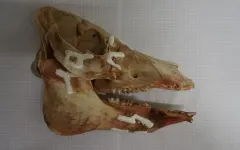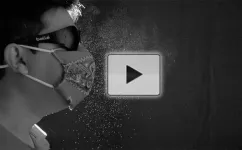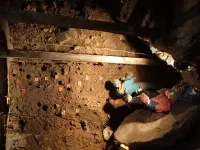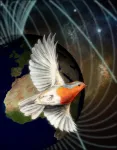Odd smell: flies sniff ammonia in a way new to science
The novel odor receptor could reveal new ways to repel pests
2021-06-23
(Press-News.org) The stink of ammonia in urine, sweat, and rotting meat repels humans, but many insects find ammonia alluring. Now, UConn researchers have figured out how the annoying insects smell it, a discovery that could lead to better ways to make them buzz off.
The sense of smell is enormously important. Mammals devote a third of their genetic code to odor receptors found in the nose, and have more than 1,000 different kinds that allow us to smell an estimated trillion different odors.
Flies don't have noses. Instead, they smell with their antenna. Each antenna is covered with tiny hairs called sensilla. Each sensilla contains a few neurons--fly brain cells. Each neuron expresses one type of odor receptor, and they all fall into two main classes. Or so scientists thought.
But recent work by UConn neuroscientist Karen Menuz and her colleagues, reported online in June in Current Biology, identified a new type of odor neuron devoted to sniffing ammonia. And the receptor it uses is unlike any other odor receptor known.
Flies and other insects use the scent of ammonia to find food sources. Mosquitoes find humans to bite by following the faint scent of ammonia in our sweat, along with other clues. Many crop pests do the same, locating fruit and agricultural products to infest and consume.
"When an odor binds to a receptor, the cell depolarizes, and sends a signal saying 'hey, the odor is here!' Insects are small, and odors come in plumes, so most insects will fly straight as long as the concentration is the same or growing. If they lose the odor plume, they'll do a casting behavior, flying in zig zags to find it," Menuz says.
Knowing exactly how the insects smell ammonia might yield effective ways to block them from following that scent plume--and from finding us and our crops.
But figuring out exactly how and what a fly smells is tricky. Menuz and her colleagues are able to gently hold a fly down and use incredibly fine pieces of glass to probe individual neurons in sensilla on the fly's antenna. Then they let the ammonia waft.
They probed all three types of scent neurons in the flies' sensilla, but they didn't respond to ammonia. But the fly was obviously smelling it. So the researchers realized there had to be a fourth scent neuron they hadn't known was there. And they found it--but it didn't seem to have the usual odor receptors on it. It was covered in ammonia transporter (Amt) a molecule that is known to allow ammonia in and out of cells.
No one had ever known a transporter molecule to also act as an odor receptor. But there it was. When they selectively killed off only that type of neuron, the flies did not respond to ammonia at all. And when the team forced scent neurons that don't normally respond to ammonia to express Amt on their surfaces, those neurons began responding to ammonia, too.
The team hopes to learn whether mosquitoes use the same system to smell ammonia. If it's used by both mosquitoes and flies, it's a good bet the Amt receptor-as-sniffer is used by all insects, and developing ways to block Amt could be an effective way to protect people and crops from pests attracted to ammonia.
INFORMATION:
ELSE PRESS RELEASES FROM THIS DATE:
2021-06-23
A new biocompatible polymer-based composite material could soon replace metal plates in treating difficult and unstable fractures. Developed at KTH Royal Institute of Technology in Stockholm, the newly-developed material is as strong as dental composites yet non-toxic.
The material and a surgical method, which were published in Advanced Functional Materials, will be used in clinical studies in 2023 and 2024, with a focus on hand fractures.
Michael Malkoch, professor of fibre and polymer technology at KTH, says that the material and method, AdhFix, will enable customized plating for fixation of fractures with a more comfortable, less complicated recovery. Collarbone and rib fractures in particular are ideally suited for the proposed treatment, ...
2021-06-23
During the COVID-19 pandemic, cloth face masks became a way to help protect yourself and others from the virus. And for some people, they became a fashion statement, with many fabric choices available. But just how effective are they, especially in containing a sneeze? Now, researchers reporting in ACS Biomaterials Science & Engineering used high-speed videos of a person sneezing to identify the optimal cloth mask design. Watch a video of the sneeze cam here.
Early in the pandemic, worldwide shortages of surgical masks and N95 respirators led many people to make or purchase cloth face masks. Now, with safe and effective COVID-19 vaccines available, mask restrictions are ...
2021-06-23
A new study published in the Journal of the Association for Consumer Research posits that increased accessibility to anthropomorphized luck (i.e., "lady luck") can lead consumers to be more likely to pursue higher-risk financial behavior. In "Lady Luck: Anthropomorphized Luck Creates Perceptions of Risk-Sharing and Drives Pursuit of Risky Alternatives," authors Katina Kulow, Thomas Kramer, and Kara Bentley propose that preferences for higher-risk options (like lottery tickets with worse odds or investment opportunities with a low chance of return) are driven by shared risk perceptions that might engender feelings of security provided by the idea of "lady luck." This behavior, the authors note, "bodes ill for consumer welfare, given that many financial maladaptive activities ...
2021-06-23
Beyond how much cream and sugar to add to their morning brew, coffee lovers also face more serious decisions: one of those is whether or not to buy ecolabelled coffee, which advertises itself as more ethical and environmentally friendly. But whether customers are willing to pay the extra price for these perks remains an unanswered question. In a study publishing in the journal Heliyon on June 23, researchers combined data from 22 studies to conclude that in general, people are willing to pay $1.36 more for a pound of coffee that's produced in an eco-friendly way and are especially partial to coffee that's labelled "Organic."
"We hear in the media or sometimes read in the newspaper that there ...
2021-06-23
Researchers have developed a simple lab-based technique that allows them to look inside lithium-ion batteries and follow lithium ions moving in real time as the batteries charge and discharge, something which has not been possible until now.
Using the low-cost technique, the researchers identified the speed-limiting processes which, if addressed, could enable the batteries in most smartphones and laptops to charge in as little as five minutes.
The researchers, from the University of Cambridge, say their technique will not only help improve existing battery materials, ...
2021-06-23
Denisova Cave is located in the Altai Mountains in southern Siberia and is famous for the discovery of Denisovans, an extinct form of archaic humans that is thought to have occupied large parts of central and eastern Asia. Neandertal remains have also been found at the site, as well as a bone from a child who had a Neandertal mother and Denisovan father, showing that both groups met in the region. However, only eight bone fragments and teeth of Neandertals and Denisovans have been recovered so far from the deposits in Denisova Cave, which cover ...
2021-06-23
Humans perceive the world around them with five senses - vision, hearing, taste, smell and touch. Many other animals are also able to sense the Earth's magnetic field. For some time, a collaboration of biologists, chemists and physicists centred at the Universities of Oldenburg (Germany) and Oxford (UK) have been gathering evidence suggesting that the magnetic sense of migratory birds such as European robins is based on a specific light-sensitive protein in the eye. In the current edition of the journal Nature, this team demonstrate that the protein cryptochrome 4, found in birds' retinas, is sensitive to magnetic fields and could well be the long-sought magnetic sensor.
First ...
2021-06-23
Researchers rescued mice from early death caused by a muscle-weakening disease, not by correcting the flawed gene that causes it, but instead by targeting another protein in the same signaling pathway.
Led by NYU Grossman School of Medicine researchers, a new study found that an antibody treatment not only rescued young mice from a form of congenital myasthenia (CM) but also reversed disease relapse in adult mice.
Published online in the journal Nature on June 23, the study revealed new details of the cause of CM, with the better understanding guiding ...
2021-06-23
ITHACA, N.Y. - Scientists at Cornell University and the American Museum of Natural History have identified 2,034 nearby star-systems - within the small cosmic distance of 326 light-years - that could find Earth merely by watching our pale blue dot cross our sun.
That's 1,715 star-systems that could have spotted Earth since human civilization blossomed about 5,000 years ago, and 319 more star-systems that will be added over the next 5,000 years.
Exoplanets around these nearby stars have a cosmic front-row seat to see if Earth holds life, the scientists said in research published June 23 in Nature.
"From the exoplanets' point-of-view, we are the aliens," said Lisa Kaltenegger, professor of astronomy and director of Cornell's Carl Sagan ...
2021-06-23
What The Study Did: Hospital employees were surveyed about symptoms such as a rash, itching, hives or swelling around the face after receiving a messenger RNA COVID-19 vaccine.
Authors: Lacey B. Robinson, M.D., M.P.H., of Massachusetts General Hospital in Boston, is the corresponding author.
To access the embargoed study: Visit our For The Media website at this link https://media.jamanetwork.com/
(doi:10.1001/jamadermatol.2021.2114)
Editor's Note: The article includes conflicts of interest and funding/support disclosures. Please see the article for additional information, including other authors, ...
LAST 30 PRESS RELEASES:
[Press-News.org] Odd smell: flies sniff ammonia in a way new to science
The novel odor receptor could reveal new ways to repel pests



